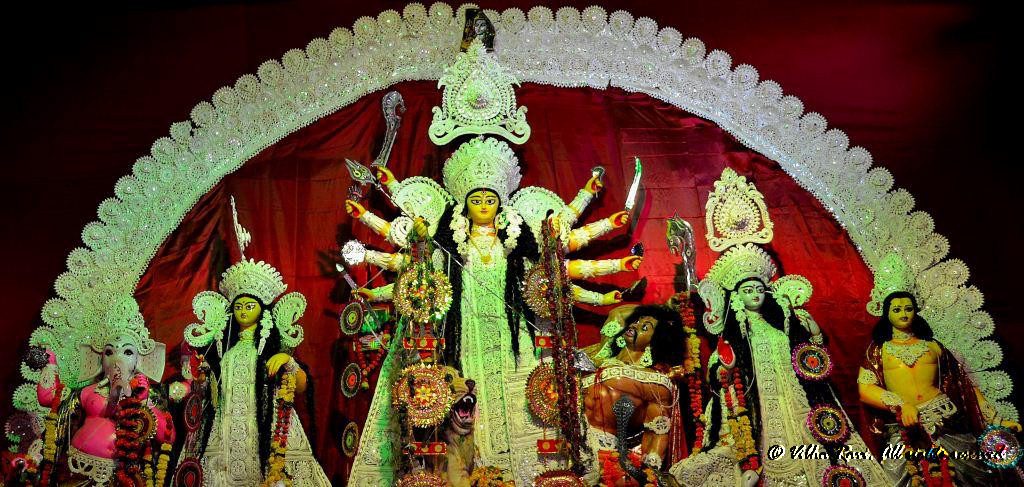Durga Puja, which marks the slaying of a demon king by lion-riding, ten-armed Goddess Durga, is celebrated throughout India but no other state does it as well as West Bengal.
Mumbai city has its share of celebrations though. Being the cultural melting pot that it is, this period of ‘Navratri ‘(nine nights literally) could be a time for dandiya/garba (traditionally Gujarati form of dancing), fasting and puja and/or Durga pandal (marquee) hopping – -depending on your age, your religious inclinations and your ‘fun quotient’. These events lead up to ‘Vijaya Dashami’ (vijaya/victory of good over evil being achieved on the tenth day) or ‘Dussehra’– the day that kids get to see an idol of the evil Ravana bursting into flames.
As children, we used to look forward to this spectacle.
Children at a Durga Pooja pandal or marquee
Indian drums or dhol play during the celebrations
People take pictures of drummers
A Baul or mystic minstrel from Bengal adds to the devotional atmosphere
A Dandiya performance
Among all offerings, a coconut is considered the purest and is offered at most Indian poojas
An auspicious light or diya is a must at any Indian pooja
Part of decoration at the pandal
This year I happened to visit the pandals on the day of Vijaya Dashami and witnessed ‘sindur khela’. A tall wooden platform had been constructed so that women could reach the idol of the goddess, which normally towers well above reach. Dressed in beautiful, traditional saris, they were applying vermillion or ‘sindur’ to her forehead and later smearing it on each other’s faces.
My curiosity aroused, I came home and googled ‘sindur khela’ – yes, am not that culturally tuned in! Turns out, Goddess Durga is believed to descend on earth on the sixth day or ‘shashthi’, along with her children Laxmi, Saraswati, Kartika and Ganesha.
After ‘saptami’ when nine types of plants are worshipped as a symbol of the goddess and ‘ashtami’ when unmarried, young girls or ‘kumaris’ are worshipped, Goddess Durga is believed to depart for her heavenly abode on the tenth day. On this day, married women offer vermilion, betel leaves and sweets to the Goddess and her children. Then they smear each other with the red powder and pray for the longevity of their spouses and prosperity of their family.
‘Sindoor Khela ‘is a celebration of Goddess Durga’s married status. It’s also believed that if this ritual is conducted properly, a married woman will never have to face widowhood.
Women apply sindoor to Goddess Durga
A close-up of Goddess Durga in a marquee
Sindoor khela
In Mumbai, the farewell ceremony for the Goddess seems pretty much like that for Lord Ganesh. Depending on the size of the idol, hand carts, tempos or trucks are entrusted with the responsibility of transporting the goddess to the nearest water body.
Neon lights focussed on the idols, people trailing behind swinging incense filled earthen burners, drums beaters drumming their hearts out, devotees of all shapes and sizes swinging to these beats, coloured powder being thrown around – I just love the atmosphere and hope I have managed to re-create it for you in some part.
A tempo carries an idol of Goddess Durga for immersion
People accompany the idol
Coloured powder is thrown with gay abandon
The smell of incense fills the air
Some Bengali women walk barefoot in the procession
Goddess Durga leaves for her heavenly abode
If you liked this post, you might also want to read about Ganesh Chaturthi or Ganesh Utsav (festival) in Mumbai. It’s without doubt the liveliest sight in Maharashtra state- one that sees people thronging to ‘chowpatties’ or beaches on the day that Lord Ganesh is taken for immersion. The fun begins long before that though.
